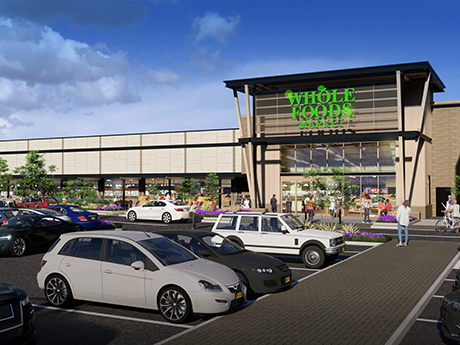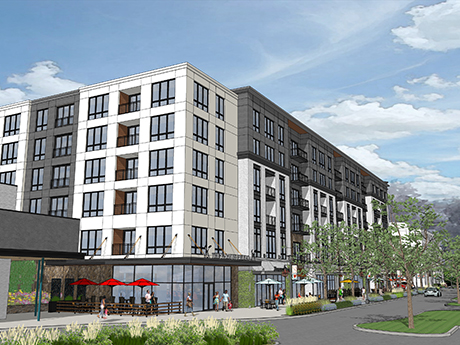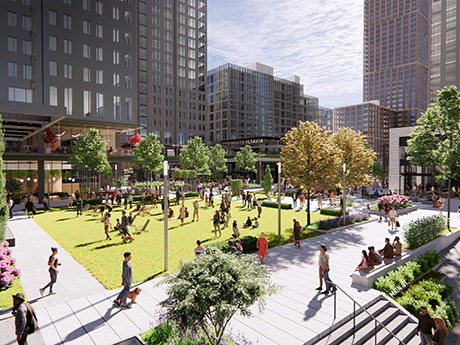If the whole mall redevelopment thing doesn’t work out, you can always become a marriage counselor.
Perhaps some additional training and education would be needed for such a career transition to actually take place. But mall and shopping center owners who undertake high-risk redevelopments undoubtedly have firsthand appreciation of the importance of providing clear and courteous communication to the many different groups they deal with, from municipal leaders to longstanding tenants to onsite contract workers.
That’s not to say that poor communication will necessarily kill a mall redevelopment. The inability to secure zoning overlay districts, civic partnerships for infrastructural improvements or feasibly priced construction loans in 2024 — these are variables over which mall owners have limited control and can actually sink these projects in their infancy. And those factors only come into play once the development team has done its due diligence and determined what uses and levels of density the project will feature.
“After you’ve considered the macro-level needs of the market and the asset itself, you enter a phase that we call ‘the minefield map,’” says Steve Plenge, CEO of Pacific Retail Capital Partners. “Reciprocal easement agreements [that regulate design or tenancy issues] by parties with ownership stakes in the property, sight line restrictions, no-build zones to maintain parking ratios, modifications to ingress/egress — those orders of business are addressed once you’ve decided to densify the site.”
With so many potential pitfalls and unknowns surrounding these projects, there is value and mental relief in having some sense of control. Communicating an articulate vision for the property that details the ways in which the redevelopment will add value to the tenancy, real estate and surrounding community is a controllable factor. And it goes a long way in terms of garnering support for and smoothly executing such projects.
Najla Kayyem, Pacific Retail’s executive vice president of marketing, emphasizes the importance of starting these processes as early as possible and applying them to all relevant parties.
“Communication starts 18 to 24 months before we put shovels in the ground,” she says. “We’re telling a story and making sure tenants align with the vision and see what’s in it for them. Then we align with stakeholders, including retailers, but also investors, municipalities and the greater community and nonprofit groups that have voices and want to see their community shaped a certain way.”
Kayyem adds that the company has found unique ways to get shoppers and tenants involved, such as giving sales associates buttons and flares that say, “ask me what’s going on with the makeover,” or something to that effect. Undertaking such measures makes people feel like they’re involved in the process and bolsters their faith in the ultimate vision and success of the project, she says.
Pacific Retail is currently underway on the redevelopment of the former Galleria at White Plains Mall, a 900,000-square-foot shopping and dining destination of 1980s construction that is located about 30 miles north of Manhattan. The Los Angeles-based owner-operator plans to redevelop the site into a residential and entertainment district in the downtown area with thousands of apartments and ample open green space.
The project, now known as District Galleria, speaks to the reality that mall redevelopments vary tremendously in terms of their scope and depth. In this case, the redevelopment represents an extreme end of the spectrum: a complete teardown and rebuild with drastically different uses. But Plenge says it couldn’t have happened any other way.
“When we embark on a redevelopment, we have to have conviction that the property has validity and can be enhanced with residential instead of residential saving a failed mall product,” he explains. “If a mall is struggling to maintain occupancy and relevance, simply adding residential on the outside probably isn’t going to save it.”
“So after an extensive study, we decided to tear it down and start with a new vision of 10 acres on two major city blocks in the heart of White Plains, 100 yards from a train station from which you can get to Grand Central in 30 minutes,” Plenge continues. “We developed an open-air plan with subterranean parking that addresses the area’s shortage of housing, and the city has been very supportive.”
The Cappelli Organization, SL Green Realty Corp. and Aareal Bank are all partners on District Galleria, which will also feature a quarter-mile-long promenade with pet playgrounds, pocket parks and landscaping for community gatherings and outdoor entertainment events. Pacific Retail’s catalog of ongoing mall redevelopments also includes Bridgewater Commons, a 1.2 million-square-foot mall in Northern New Jersey that the company acquired in May 2023. Future plans for that site are still being hashed out.
Varied Approaches
As principal of Boston-based owner-operator Wilder Cos., Tom Wilder has been involved in dozens of mall and shopping center redevelopments throughout his career. The company is perhaps best known for Arsenal Yards, its redevelopment of a 1980s-era mall in metro Boston into a mixed-use development with new-age uses like life sciences.
In Wilder’s view, the ability to sell local communities on the value and upshot of mall redevelopments is made easier by the fact that these properties have excellent underlying locations and infrastructure. They just need to be populated with new concepts.

“These sites are all well-located from their days as thriving regional malls, and usually the infrastructure is in place in terms of offsite improvements to accommodate the traffic you’re going to drive,” he explains.
Wilder adds that now that mall redevelopment has proven to be a successful business plan, it’s easier to line up municipal support.
“The impacts that mall redevelopments have in terms of value creation and growth in the tax base are huge,” he says. “These municipal leaders have a lot of pride in their communities and are starting to recognize how revitalizing old malls helps the tax base. In some cases, they’re approaching us and asking how they can help.”
Some retail owner-operators are turning to technology to guide their communications with tenants, shoppers and stakeholders in their mall or shopping center redevelopments. Maryland-based Federal Realty Investment Trust is one of them.
“In 2023, we were nearing completion of a multimillion-dollar redevelopment of Lawrence Park Shopping Center, a 360,000-square-foot development located outside of Philadelphia in Broomall,” explains Kari Glinski, Federal Realty’s vice president of asset management. “We used placerAI and mobile phone data to compare the foot traffic pre-redevelopment and post-redevelopment and found that it grew by 20 percent post-redevelopment.”
“That traffic is driving sales for existing businesses and also demonstrating that the community supports our project because there are now more people coming and returning more often,” she continues. “When we have dialogue with tenants as we’re going through these processes, we’re describing what the outdoor dining, placemaking and changes in parking will bring. It all really drives foot traffic and additional merchandising.”
Glinski adds that the 20 percent figure may actually be too modest; Federal Realty is still waiting on two new tenants — Sephora and Kindercare — to open at Lawrence Park.
Another Philadelphia-area redevelopment is also in the works for Federal Realty. The company is converting a 306,500-square-foot shopping center in Willow Grove into a mixed-use destination with apartments and green space. Tenants that have either opened stores or committed to the property include Marshalls, Five Below, Dave’s Hot Chicken, Hand & Stone Massage & Facial Spa and Orangetheory Fitness.
Still, some owners prefer to go the old-fashioned route in terms of word-of-mouth communication and traditional marketing devices.
St. John Properties, a Baltimore-based developer that recently embarked on its first mall redevelopment — the conversion of the 1 million-square-foot Harrisburg Mall in Central Pennsylvania into a primarily office and industrial campus — is one such company. Known as Swatara Exchange, the project will retain the existing anchor tenant, Bass Pro Shops, and a freestanding Applebee’s restaurant.
Bill Holzman, vice president of retail leasing at St. John Properties, says he knew there would be some challenges in obtaining support for Swatara Exchange. But by borrowing pages from its playbook on other projects — namely doing its homework and engaging in early, thoughtful communication with the key parties — St. John was able to get the support it needed.
“We’ve always been big on early and frequent communication,” he recalls. “We did our outreach and were able to communicate our vision, and we started getting feedback early on rather than just jumping right into the process. This is a traditional approach that our development team typically takes by meeting with the right people, explaining our stance, getting their feedback and refining things from there.”
The company took the same approach with its anchor tenant, knowing how important that entity’s role is in this process (more on that below).
“As soon as the vision started coming together, we approached Bass Pro Shops more than a year before actual work started to read their reactions and hear their immediate thoughts and concerns, which, fortunately for us, were positive,” Holzman says.
“During that initial conversation, they were glad we were thinking forward because the company also recognized that the property was not going to succeed long term as a traditional mall with how things were going,” he continues. “We shared detailed plans and schedules just to get everything off on the right foot.”
Demolition work on the mall is expected to conclude in 2025, at which point new uses and plans will be announced.
Anchor Ouster
Sources agree that the departure of an anchor tenant can often be the catalyst for kicking off mall redevelopments. Further, the vetting and evaluation processes that take place after the fact can be practice for the communication that needs to happen once the redevelopment really gets rolling.
“Vetting these projects includes assessing the location of the asset, the merchandising and the fundamentals of the property itself,” says Glinski. “We may also determine during this stage that the physical infrastructure of the asset no longer serves the community or really meets the demand for leasing for either tenants or shoppers.”
Federal Realty recently received approval for a major piece of its redevelopment of Bala Cynwyd Shopping Center, also located in metro Philadelphia. This latest phase of the project will convert a 120,000-square-foot former Lord & Taylor department store into a 217-unit apartment complex with 16,000 square feet of ground-floor retail space. Construction is slated for a 2026 completion.
Glinski says that one reason Federal Realty pursued this avenue of redevelopment was because backfilling the vacated Lord & Taylor store was exceptionally challenging, but its strategic location right outside Philadelphia was instrumental to the fundamentals of the redevelopment. The new multi-use development will complement the existing 150,000 square feet of retail and restaurant space, which underwent a multi-million dollar exterior façade renovation and streetscape refresh ahead of the planned residential redevelopment.
Wilder’s pipeline includes two mall redevelopments in the New England area that will be announced in the coming months. Without going into premature detail, the company principal says both will be “scrape jobs.” In addition, he says that the impetus to pull the trigger on both deals was the departure of the anchor tenants.
“The reason we’re able to scrape [these malls] is because the department stores have closed and we’ve acquired the land or lease rights,” he explains. “That’s the challenge when a mall starts to fail — you have to get pretty far down the road before it can be released from its encumbrances and opened to new opportunities. So we’re acquiring properties that are fairly far along in terms of their demise and the creation of opportunities to redevelop.”

Wilder’s current redevelopment of Walpole Mall, located southwest of Boston, exemplifies this strategy in action. When the property was acquired in 2023, only a portion still existed, but it boasted a powerful lineup of anchor tenants: Kohls, Barnes & Noble, LA Fitness, PetSmart and Old Navy.
Wilder plans to utilize the redeveloped mall space to complement those anchors with more food-and-beverage and entertainment tenants — and of course ample green space — to cater to the area’s healthy population of young families. “It’s an opportunity to take dormant space of 50,000 square feet and create more areas for social engagement,” Wilder says.
In the Long Island community of Holbrook, Florida-based owner-operator Regency Centers is underway on its redevelopment of the 280,000-square-foot former SunVet Mall into a grocery-anchored shopping center that will be known as The Shops at SunVet. The name stems from the location of the property, which was built in the 1970s, at the intersection of Sunrise Highway and Veterans Memorial Highway.
Like most other mall redevelopments, the potential for success was tied to the highly trafficked location and visibility — traits that made the mall successful in its heyday.
“Those same ingredients apply to grocery-anchored center locations and make them work as regional draws,” says Rebecca Wing, Regency’s vice president of investments. “In addition, we knew of several top-tier grocers that were looking for homes in this market, which is underserved by that type of user. Initial conversations with other retailers in a range of categories also revealed enthusiasm for expansion in the area.”
Just as important, Wing says, was the fact that none of the mall’s original anchor tenants were still open and operating. These included, at various points in time, now-defunct chains like RadioShack and home-improvement concept Rickel’s. Retailers that have filed for bankruptcy in recent years, such as Sears and Toys ‘R’ Us, also once operated stores at SunVet Mall.
More recently, an existing tenant, Citi Bank, committed to moving its space from within the mall to an outparcel building, further clearing the way for new construction in the future.
“With their stores all closed, there weren’t any anchor tenant stakeholders that normally have a lot of control over the site, which would have complicated the process [of redevelopment],” says Wing. “So it was a little simpler for us to work with the few tenants that were remaining.”
The fact that some other groups had already made inroads in redeveloping the mall was also helpful, Wing says. Municipal leaders had already approved and supported some of those efforts; Regency’s task was to expound and improve upon those plans. And with 10-plus Long Island shopping centers in its portfolio, Regency had the market knowledge that local leaders knew could get the project across the finish line.
“At the time we came aboard, there had already been some initial conversations with the town, and there was a site plan that had been approved,” Wing explains. “We re-thought that plan to make it more pedestrian-friendly and have more small-shop space as opposed to larger boxes and give it the feel of more of a community-oriented center instead of just strip retail. That was very well-received by the town.”
More tenant announcements for Shops at SunVet will be made later this year, but Whole Foods Market has already committed as the new grocery anchor. And although all parties are seemingly on the same page in terms of their commitment to Regency’s vision, Wing says the company will continue to stick to its principles of communication.
“We weren’t really asked to provide more data for this project, but we normally make sure we meet with tenants, show them our vision and provide detailed communication for the development timeline and how traffic will be managed during construction,” she says. “Our experience has been that when tenants see us taking an almost-vacant mall with almost no foot traffic and bringing the likes of Whole Foods and other junior anchors and Class A retailers to the property, they know it’s a good thing.”
—Taylor Williams


